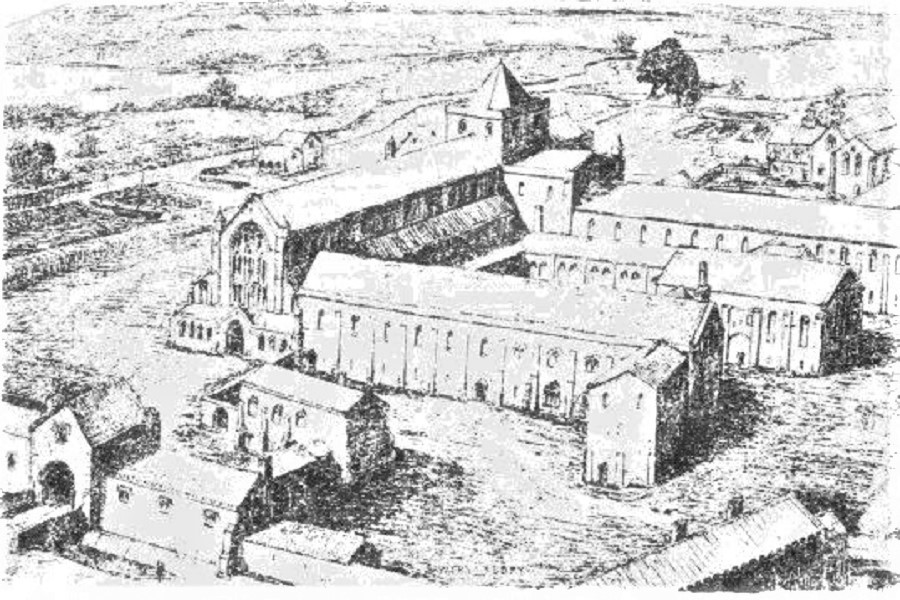Sawtry Abbey was the subject of a 10 minute “Open-Mic” talk by Kevin Redgate at the December 2022 FRAG meeting. With his small team from Sawtry History Society he has been researching the abbey for several years and has undertaken a geophysical survey of the site.
Kev has kindly asked to share his powerpoint slides – and there is more information both on this website, and on that of the Sawtry archaeology group.
Slide #1: Background
Abbey heraldic device
Abbey Plan, Inskip Ladds 1914
Cloister Plan, Inskip Ladds 1914
Sawtry Abbey, Artist Impression 1914
Google Earth 2008
Slide #2: Location
Located in extreme northeast of Manor Sawtry Judith
East edge of the modern civil parish of Sawtry
Slide #3: Foundation
Sawtry Abbey was founded 1147
Simon II de Senlis, Earl of Northampton and Huntingdon
Founding processs:
– three stages of decisions by General Chapter (annual gathering of
all abbots in September)
– approval of the founder’s application
– appointment of a Commission
– review of the Commission’s report
– first essential buildings constructed in timber and water
management system established
– new abbey occupied by founding colony
– abbot plus 12 choir monks and a number of lay brothers
– foundation charter issued
Founding process for Sawtry Abbey probably initiated before 1144
General Chapter
Around 1192 construction of first stone buildings started, separate from
timber buildings:
– church in first instance
The church was dedicated (to St Mary in Her honour) in 1238:
– minimum, east end (presbytery) with high alter completed
Filial lineage:
– Warden Abbey (motherhouse), Rievaulx, Clairvaux and Citeaux
– 2 sibling abbeys; Sibton (Yoxford, Suffolk) and Tilty (Essex)
Total of 65 Cistercian foundations in England
27 before 1147; 5 others in 1147
Sawtry foundation during the period known as The Anarchy:
– the civil war of 1135 – 1153 between King Stephen and the
Empress Matilda
Total of 38 (60%) of all English Cistercian foundations during this period
Reasons for founding:
Piety to seek everlasting salvation
Defiance to prevent foe from obtaining lands
Political reasons to curry favour with factions and nobility
Expiation for violence done on the field of battle
The abbey was endowed with the manor of Sawtry Judith and
miscellaneous lands Bedfordshire, Cambridgeshire, Lincolnshire,
Northamptonshire and Norfolk
The abbey had two granges in Sawtry Judith by 1285:
– one of which was a vacary (one of 21 abbeys to specialize in cattle
husbandry)
– the lands in the other counties probably insufficient and too dispersed to
establish other granges
Slide #4: Importance
Never wealthy abbey, valued in the Monasticon Anglicanum 1692 at
£141 3 8 at dissolution
– 17 Cistercian abbeys with less wealth than Sawtry at dissolution
– 3 richest Cistercian abbeys valued at dissolution:
— Fountains Abbey, Yorkshire at £998 6 8
— Furness Abbey, Lancashire at £805 16 5
— The Abbey of Grace, London at £546 10 0
Context; neighbouring Benedictine abbeys of Peterborough £1,721 14 0,
Ramsey £1,716 12 4, Ely £1,084 6 9, and Thorney £411 12 11
Slides #5, #6, #7: Size
Sawtry was not a large abbey; inner precinct approximately 15 acres
Church approximately 175′ in length; approximately 47′ in width at the
nave and presbytery; transept was approximately 79′ in length
(north/south) and approximately 44′ in width – including side chapels
Average garth 80′-120′ square
Sawtry was approximately 80′ square
Slides #8, #9, #10, #11, #12, #13, #14: Life & Dissolution
Sawtry was not a motherhouse and did not provide a founding colony, so
unlikely to have had more than 60 choir monks at any one time
(An abbey was required to have more than 60 choir monks in order
to provide a founding colony, so that it would not suffer from the loss
of 13 of its number)
Sawtry was dissolved in 1536 under the Suppression of Religious Houses
Act 1535, also known as:
First Suppression Act (1535)
Act for the Dissolution of the Lesser Monasteries
Dissolution of Lesser Monasteries Act



